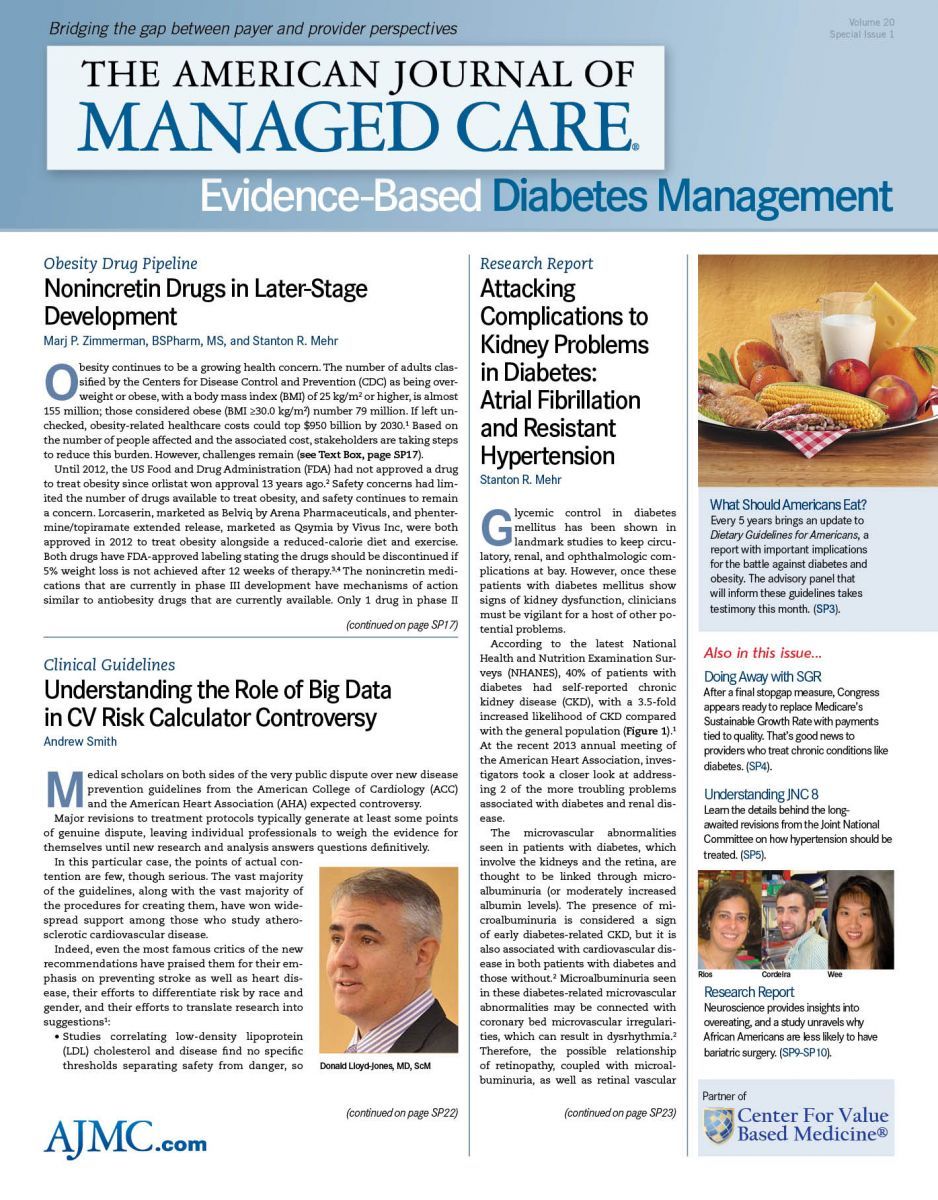- Center on Health Equity & Access
- Clinical
- Health Care Cost
- Health Care Delivery
- Insurance
- Policy
- Technology
- Value-Based Care
Dangerous Liaisons: Obesity and Diabetes
Approximately 80% to 90% of Patients Diagnosed With Type 2 Diabetes Mellitus Are Also Obese
One can hardly discuss obesity without mentioning type 2 diabetes mellitus (T2DM). The association is so strong, it has given rise to a new term—diabesity. Approximately 80% to 90% of patients diagnosed with T2DM are also obese.1 While not fully accurate, the body mass index (BMI) is used to assess obesity. BMI is weight (kg)/height (m2) (Table 1). The statistics on obesity and diabetes are staggering (Table 2).
According to the World Health Organization, obesity and T2DM are the biggest public health challenges in this century,10 and obesity’s prevalence continues to increase. In 2000, no single state had an obesity prevalence rate above 20%. By 2012, every state had a rate exceeding 20%, with Mississippi having the highest rate (34.6%) and Colorado having the lowest (21.5%).5 Both obesity and T2DM reduce life expectancy and quality of life.11
Causative Factors
The causes of obesity and T2DM are similar: the convenience of fast food; a sedentary lifestyle and high calorie intake; and easy access to high-sugar drinks. Additionally, a genetic link for obesity has been established. Evidence from adoption studies indicates a high correlation between adoptees’ BMI and biological parents, but not with the adoptive parents. Genetics, however, accounts for a small variance in BMI, suggesting that environmental and lifestyle variables remain key contributors.8
The relationship between T2DM and obesity appears to be bidirectional. Obesity precedes T2DM, and T2DM may precede obesity. Weight gain is common among patients diagnosed with T2DM, but studies indicate obesity is more likely to precede T2DM.8,9
Metabolic Syndrome
Metabolic syndrome is composed of a cluster of cardiovascular risk factors (hypertension, altered glucose metabolism, dyslipidemia, and abdominal obesity). Approximately 25% of the adult population meet the criteria for this syndrome.12
Metabolic syndrome is associated with an increased risk for cardiovascular disease and T2DM, along with various other clinical conditions.12 A person with metabolic syndrome is twice as likely to develop heart disease and 5 times as likely to develop T2DM as someone without metabolic syndrome.13 Treating metabolic syndrome early decreases the risk of cardiovascular disease and T2DM.
Treatment
Treating obesity and T2DM entails a combination of dietary, physical activity, and lifestyle changes.3 Medications may also be used. Orlistat, lorcaserin hydrochloride, phentermine, and phentermine/topiramate are FDA approved for treating obesity. Antidepressants, anticonvulsants, and metformin are used off label.2
Additionally, group interventions are very effective in decreasing weight and improving glycemic control. Among older adults, group interventions are more successful than one-on-one training.14
Bariatric Surgery
Approximately 5% of adults are morbidly obese, making them candidates for bariatric surgery. Bariatric surgery leads to significant weight loss, improved glycemicduction in depression, improved sexual activity, and decreased sleep apnea. One study showed that after the surgery, 78% of patients had complete resolution of T2DM, and 62% were in remission 1 year after surgery.15
Counseling
Counseling’s focus is on controlling obesity and T2DM. If a patient is on weightreduction medications or glycemic-control medications, counseling begins with reviewing the medications’ side effects.
Pharmacists can help control the onset of obesity by counseling patients and encouraging certain lifestyle changes (Table 3).
The United States previously had the dubious distinction of being the fattest country in the world. It is now in second place; Mexico is first. While some may see this as progress, we have a long
way to go before earning the title of the healthiest country in the world.
References
1. Diabetes Care Services. A codependent relationship: diabetes and obesity. www.diabeticcareservices.com/diabetes-education/diabetes-andobesity.Accessed August 20, 2013.
2. National Heart, Lung, and Blood Institute. What are overweight and obesity? www.nhlbi.nih.gov/health/health-topics/topics/obe. Accessed August 24, 2013.
3. Carvajal R, Wadden TA, Tsai AG, Peck K, Moran CH. Managing obesity in primary care practice: a narrative review. Ann N Y Acad Sci. 2013;1281:191-206.
4. Best M. The growing challenge of “diabesity.” National Institutes of Health. www.nlm.nih.gov/medlineplus/magazine/issues/winter08/articles/winter08pg12.html. Accessed August 20, 2013.
5. Centers for Disease Control and Prevention. Adult obesity facts. www.cdc.gov/obesity/data/adult.html. Accessed August 24, 2013.
6. National Institute of Diabetes and Digestive and Kidney Diseases. National diabetes statistics, 2011.www.diabetes.niddk.nih.gov/dm/pubs/statistics.Accessed August 20, 2013.
7. National Institute of Diabetes and Digestive and Kidney Diseases. Overweight and obesity statistics.http://win.niddk.nih.gov/publications/PDFs/stat904z.pdf. Accessed August 24, 2013.
8. Xia Q, Grant SF. The genetics of human obesity.Ann N Y Acad Sci. 2013;1281:178-190.
9. The NS, Richardson AS, Gordon-Larsen P. Timing and duration of obesity in relation to diabetes: findings from an ethnically diverse, nationally representative sample. Diabetes Care. 2013;36:865-872.
10. World Health Organization. Obesity. www.euro.who.int/en/what-we-do/health-topics/noncommunicable-diseases/obesity. Accessed August 23, 2013.
11. Leidy H. The benefits of breakfast consumption to combat obesity and diabetes in young people.Am J Lifestyle Med. 2013;7:99-103.
12. Weiss R, Bremer AA, Lustig RH. What is metabolic syndrome, and why are children getting it? Ann N Y Acad Sci. 2013;1281:123-140.
13. National Heart, Lung, and Blood Institute. What is metabolic syndrome? www.nhlbi.nih.gov/health/health-topics/topics/ms. Accessed August 24, 2013.
14. Beverly EA, Fitzgerald S, Sitnikov L, et al. Do older adults aged 60-75 years benefit from diabetes behavioral interventions? Diabetes Care.2013;36:1501-1506.
15. Azizi F. Bariatric surgery for obesity and diabetes.Arch Iran Med. 2013;16:182-186.

Trends in Hospital Pricing for Vulnerable Emergency Department Users, 2021-2023
December 4th 2025Self-pay emergency department prices rose significantly from 2021 to 2023, especially at for-profit and system-affiliated hospitals, highlighting growing affordability challenges for uninsured and underinsured patients.
Read More
Exploring Pharmaceutical Innovations, Trust, and Access With CVS Health's CMO
July 11th 2024On this episode of Managed Care Cast, we're talking with the chief medical officer of CVS Health about recent pharmaceutical innovations, patient-provider relationships, and strategies to reduce drug costs.
Listen
Integrated Care for Chronic Conditions: A Randomized Care Management Trial
December 3rd 2025The authors sought to understand the differential impact of payer-led community-based care management approaches on stakeholder-oriented outcomes for publicly insured adults with multiple chronic conditions.
Read More
